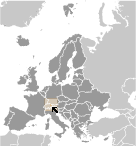World Atlas: Liechtenstein. On this page you can see the map, country flag and many detailed information about the people, history and economy of Liechtenstein.

Here you can find online selected information about the geography, inhabitants, government, economy and history of Liechtenstein. Included are selected statistics, an overview map and the detailed map of Liechtenstein. But let's start with the flag of Liechtenstein here:
Liechtenstein - Overview:
What you should know about Liechtenstein? Let's start with this: The Principality of Liechtenstein was established within the Holy Roman Empire in 1719. Occupied by both French and Russian troops during the Napoleonic Wars, it became a sovereign state in 1806 and joined the German Confederation in 1815. Liechtenstein became fully independent in 1866 when the Confederation dissolved. Until the end of World War I, it was closely tied to Austria, but the economic devastation caused by that conflict forced Liechtenstein to enter into a customs and monetary union with Switzerland. Since World War II (in which Liechtenstein remained neutral), the country's low taxes have spurred outstanding economic growth. In 2000, shortcomings in banking regulatory oversight resulted in concerns about the use of financial institutions for money laundering. However, Liechtenstein implemented anti-money laundering legislation and a Mutual Legal Assistance Treaty with the US that went into effect in 2003.
Geography of Liechtenstein
 Where on the globe is Liechtenstein? The location of this country is Central Europe, between Austria and Switzerland. Total area of Liechtenstein is 160 sq km, of which 160 sq km is land. So this is quite a small country. How could we describe the terrain of the country? This way: mostly mountainous (Alps) with Rhine Valley in western third. The lowest point of Liechtenstein is Ruggeller Riet 430 m, the highest point Vorder-Grauspitz 2,599 m. And the climate is continental; cold, cloudy winters with frequent snow or rain; cool to moderately warm, cloudy, humid summers.
Where on the globe is Liechtenstein? The location of this country is Central Europe, between Austria and Switzerland. Total area of Liechtenstein is 160 sq km, of which 160 sq km is land. So this is quite a small country. How could we describe the terrain of the country? This way: mostly mountainous (Alps) with Rhine Valley in western third. The lowest point of Liechtenstein is Ruggeller Riet 430 m, the highest point Vorder-Grauspitz 2,599 m. And the climate is continental; cold, cloudy winters with frequent snow or rain; cool to moderately warm, cloudy, humid summers.
Inhabitants of Liechtenstein
Let's take a look how many people live in Liechtenstein. The number is: 38,244 (July 2017 est.). So not so many people live here. Who lives here? Liechtensteiner 66%, other 34% (2013 est.). What are the languages in Liechtenstein? German 94.5% (official) (Alemannic is the main dialect), Italian 1.1%, other 4.3% (2010 est.). And the religions: Roman Catholic (official) 75.9%, Protestant Reformed 6.5%, Muslim 5.4%, Lutheran 1.3%, other 2.9%, none 5.4%, unspecified 2.6% (2010 est.). How old are the people in average? 43.2 years. We have to add that this number is the median - so one half of the people is older than this, one half is younger. And what is their life expectancy (at birth)? This: 81.9 years. Where the people live in Liechtenstein? Here: most of the population is found in the western half of the country along the Rhine Rive. The major urban areas of Liechtenstein are: Vaduz (capital) 5,000 (2014).
Government and Economy of Liechtenstein
The capital of Liechtenstein is Vaduz and the government type constitutional monarchy. Let's take a look at the administrative divisions - 11 communes (Gemeinden, singular - Gemeinde); Balzers, Eschen, Gamprin, Mauren, Planken, Ruggell, Schaan, Schellenberg, Triesen, Triesenberg, Vaduz. Regarding the economy of Liechtenstein, important industrial products are electronics, metal manufacturing, dental products, ceramics, pharmaceuticals, food products, precision instruments, tourism, optical instruments. Important agricultural products are wheat, barley, corn, potatoes; livestock, dairy products. The most important export commodities are small specialty machinery, connectors for audio and video, parts for motor vehicles, dental products, hardware, prepared foodstuffs, electronic equipment, optical products and the most important export partners are unknown. The most important import commodities are agricultural products, raw materials, energy products, machinery, metal goods, textiles, foodstuffs, motor vehicles and the most important import partners are unknown. How rich is Liechtenstein and how rich are people in this country? The most important number here is GDP per capita (PPP): $139,100 (2009 est.). So the people are extremely rich on average here. Let's add that this means Gross Domestic Product per person, which is recalculated with respect to the relative cost of local goods and services. And one more important number - population below poverty line: NA%.